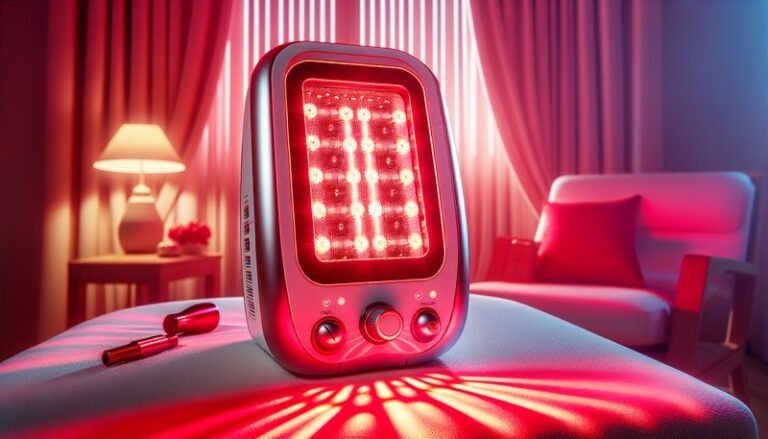Can Red Light Therapy Help Melasma?
Are you struggling with melasma and curious if red light therapy could be the solution you’ve been searching for?
This article will delve into the relationship between red light therapy and melasma, exploring the science behind the treatment, its potential benefits, and what you should consider before trying it. We aim to provide a comprehensive overview and help you make an informed decision regarding your skin health.
Key Takeaways
- Red light therapy may improve melasma by promoting collagen production and reducing inflammation.
- It is a non-invasive treatment option, posing fewer risks compared to more aggressive treatments.
- While promising, red light therapy is not a guaranteed cure for melasma and results can vary.
What is Red Light Therapy?
Red light therapy (RLT) involves the use of low-level wavelengths of red light to treat various skin conditions. Also known as low-level laser therapy (LLLT), this non-invasive procedure penetrates the skin and stimulates cellular processes, including energy production and inflammation reduction.
Discover the full story Best Time for Red Light Therapy?
See our post on Can Red Light Therapy Aid Fertility?
Historically, red light has been utilized in medical settings for wound healing, pain relief, and reducing inflammation. Recently, it gained popularity in cosmetic treatments, particularly for skin issues like acne, wrinkles, and melasma.
What are the Benefits of Red Light Therapy?
Red light therapy offers several advantages, especially for individuals with melasma. Here are some notable benefits:
Supports Skin Health
Red light therapy can enhance skin health by promoting collagen synthesis, which is essential for maintaining skin elasticity and reducing discoloration over time.
Reduces Inflammation
Many skin conditions, including melasma, can be exacerbated by inflammation. RLT is known for its anti-inflammatory properties, potentially leading to calmer and healthier skin.
Enhances Circulation
By improving blood flow, red light therapy can facilitate the delivery of oxygen and nutrients to skin cells, supporting overall skin rejuvenation and vitality.
Boosts Cellular Energy
RLT encourages the production of ATP (adenosine triphosphate), the energy currency of cells. Increased ATP production can promote cellular repair and regeneration.
Is it Possible to Treat Melasma with Red Light Therapy?
Yes, red light therapy is considered a possible treatment option for melasma. However, while many practitioners and patients report positive experiences, it is essential to understand that results can be inconsistent and vary from person to person.
What are the Advantages of Using Red Light Therapy for Melasma?
- Non-invasive: RLT does not involve needles or surgeries, making it a painless alternative.
- Minimal downtime: Unlike chemical peels or laser treatments, patients can typically return to their usual activities immediately after treatment.
- Accessibility: With a range of home devices available, people can use RLT in the comfort of their homes.
What are the Disadvantages of Using Red Light Therapy for Melasma?
- Variable results: Not everyone will experience improvement, and it may take several sessions before seeing any changes.
- Cost: Regular treatments can become expensive, especially if opting for professional sessions.
- Lack of regulation: The industry surrounding home devices is not strictly regulated, leading to concerns about efficacy and quality.
What are the Things to Consider Before Trying Red Light Therapy?
Before deciding on red light therapy, it is important to weigh several factors to ensure you’re making the best choice for your skin.
Skin Type and Sensitivity
Consider your skin type and any sensitivities. Consult a dermatologist to assess whether RLT is suitable for your specific condition.
Combination with Other Treatments
Think about whether you are currently using other treatments for melasma. Combining therapies can sometimes lead to better results but may also increase the risk of irritation.
Time Commitment
Understand the commitment in terms of time and frequency of sessions required to potentially achieve results.
What are the Alternatives to Red Light Therapy?
If red light therapy doesn’t seem like the best fit for you, consider these alternative treatments for melasma.
Topical Treatments
Prescription creams containing ingredients like hydroquinone, tretinoin, or azelaic acid can help lighten melasma and improve skin tone.
Chemical Peels
These treatments involve applying a chemical solution to the skin, promoting exfoliation and cell turnover, which can reduce melasma pigmentation.
Laser Treatments
Laser therapies, such as fractional lasers, target melasma spots more aggressively. Although effective, these can require a longer recovery time.
Conclusion: Is it Recommended to Try Red Light Therapy for Melasma?
While red light therapy shows promise in treating melasma by promoting skin health and reducing inflammation, it is not without limitations. Individual results can vary, and it may not be suitable for everyone. Consulting a qualified dermatologist can help determine if red light therapy is the right choice for your skin condition, along with considering alternative treatments.
Frequently Asked Questions
How long does it take to see results from red light therapy for melasma?
Results vary significantly across individuals, but many people may start to notice improvements after 4 to 6 weeks of regular sessions.
Is red light therapy safe for all skin types?
Generally, RLT is considered safe for all skin types. However, individuals with specific skin conditions should consult with a dermatologist before beginning treatment.
Can I use red light therapy at home?
Yes, there are various at-home red light therapy devices available. However, it’s essential to choose high-quality products and follow usage guidelines to achieve the best results.
What should I look for in a red light therapy device?
Look for devices that have clinically proven specifications, such as the right wavelength range (typically between 600 to 650 nanometers) and adequate power output for effective treatment.






